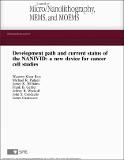| dc.contributor.author | Raja, Waseem Khan | |
| dc.contributor.author | Padgen, Michael R. | |
| dc.contributor.author | Williams, James K. | |
| dc.contributor.author | Gertler, Frank | |
| dc.contributor.author | Wyckoff, Jeffrey B. | |
| dc.contributor.author | Condeelis, John S. | |
| dc.contributor.author | Castracane, James | |
| dc.date.accessioned | 2014-01-06T17:41:34Z | |
| dc.date.available | 2014-01-06T17:41:34Z | |
| dc.date.issued | 2012-03 | |
| dc.date.submitted | 2012-01 | |
| dc.identifier.issn | 1932-5150 | |
| dc.identifier.uri | http://hdl.handle.net/1721.1/83500 | |
| dc.description.abstract | Cancer cells create a unique microenvironment in vivo that enables migration to distant organs. To better understand the tumor microenvironment, special tools and devices are required to monitor the interactions between different cell types and the effects of particular chemical gradients. Our study presents the design and optimization of a versatile chemotaxis device, the nano-intravital device (NANIVID), which consists of etched and bonded glass substrates that create a soluble factor reservoir. The device contains a customized hydrogel blend that is loaded with epidermal growth factor (EGF), which diffuses from the outlet to create a chemotactic gradient that can be sustained for many hours in order to attract specific cells to the device. A microelectrode array is under development for quantification of cell collection and will be incorporated into future device generations. Additionally, the NANIVID can be modified to generate gradients of other soluble factors in order to initiate controlled changes to the microenvironment including the induction of hypoxia, manipulation of extracellular matrix stiffness, etc. The focus of the article is to present the design and optimization of the device towards wide ranging applications of cancer cell dynamics in vitro and, ultimately, implantation for in vivo investigations. | en_US |
| dc.description.sponsorship | National Institutes of Health (U.S.) (Grant U 54-CA126511-01) | en_US |
| dc.description.sponsorship | National Science Foundation (U.S.) (Grant DBI0922830) | en_US |
| dc.language.iso | en_US | |
| dc.relation.isversionof | http://dx.doi.org/10.1117/1.jmm.11.1.013013 | en_US |
| dc.rights | Article is made available in accordance with the publisher's policy and may be subject to US copyright law. Please refer to the publisher's site for terms of use. | en_US |
| dc.source | SPIE | en_US |
| dc.title | Development path and current status of the NANIVID: a new device for cancer cell studies | en_US |
| dc.type | Article | en_US |
| dc.identifier.citation | Raja, Waseem Khan. “Development path and current status of the NANIVID: a new device for cancer cell studies.” Journal of Micro/Nanolithography, MEMS, and MOEMS 11, no. 1 (January 1, 2012): 013013. © 2012 Society of Photo-Optical Instrumentation Engineers | en_US |
| dc.contributor.department | Massachusetts Institute of Technology. Department of Biology | en_US |
| dc.contributor.department | Koch Institute for Integrative Cancer Research at MIT | en_US |
| dc.contributor.mitauthor | Gertler, Frank | en_US |
| dc.relation.journal | Journal of Micro/Nanolithography, MEMS, and MOEMS | en_US |
| dc.eprint.version | Final published version | en_US |
| dc.type.uri | http://purl.org/eprint/type/JournalArticle | en_US |
| eprint.status | http://purl.org/eprint/status/PeerReviewed | en_US |
| dspace.orderedauthors | Raja, Waseem Khan; Padgen, Michael R.; Williams, James K.; Gertler, Frank; Wyckoff, Jeffrey B.; Condeelis, John S.; Castracane, James | en_US |
| dc.identifier.orcid | https://orcid.org/0000-0003-3214-4554 | |
| mit.license | PUBLISHER_POLICY | en_US |
| mit.metadata.status | Complete | |
